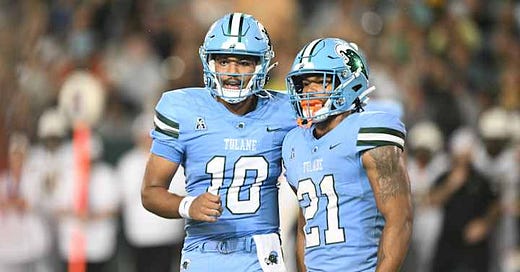The Group of Five is getting picked apart
Increasingly, the best players from the FBS' smaller conferences are fleeing for Power Four opportunities
A national champion at the highest level of college football will be crowned on Monday night, when confetti will fall from the rafters of Atlanta’s Mercedes-Benz Stadium and either Ohio State or Notre Dame will add another piece of hardware to their already robust trophy cases.
Mixed in the sea of former four- and five-star recruits who will take the field Monday night will be players who didn’t begin their careers at either school, some of whom never grew up dreaming of one day suiting up for the Buckeyes or Fighting Irish.
Will Howard and Riley Leonard, the two starting quarterbacks, began their college journeys elsewhere, coming over from Kansas State and Duke, respectively. Ohio State all-American safety Caleb Downs joined the Buckeyes last offseason after leaving Alabama. Quinshon Judkins, Ohio State’s bruising running back, came over from Ole Miss. Beaux Collins, one of Notre Dame’s top wide receivers and Leonard’s favorite targets, is a Clemson transfer in his first season with the program.
As Monday night bleeds into Tuesday morning, there’s an excellent chance that at least one of those young men will have been part of a play or a particular moment that decides a title.
The transfer portal – which is usually just short-hand for college athletes being immediately eligible if they transfer from one school to another – has changed the way rosters are built and programs across the country recruit. Though scouting and signing high-school prospects is still the central to the hopes of any championship aspirant, a team can now address its biggest deficiencies by adding a proven, experienced player – and without having to wait a year for them to take the field.
The Buckeyes and Irish are both examples of that broader shift and how it can benefit the programs that know how to effectively navigate this new landscape.
As with anything in sports, though, there are winners and losers when it comes to the transfer portal.
While increased roster turnover can often be used as a way to demonize young men who are finally able to enjoy a morsel of agency their predecessors weren’t for decades, there are people and programs that are harmed by it, the overwhelmingly of which never had a realistic shot at a championship before losing their best players to more attractive suitors.
Among the mass of schools that could loosely be described as victims in this brave new world, perhaps no one has, and is, suffering more than those in the Group of Five conferences.
The Group of Five’s talent drain
Though they both fall under the same general Football Bowl Subdivision (FBS) umbrella, there’s little, if anything, that binds the schools in the Power Four conferences and those in the Group of Five. From budgets to facilities to alumni bases, the two groups are playing different sports.
Those contrasts aren’t just apparent in a spreadsheet. Coaches and players are acutely aware of them. The Power Four level offers a player the only feasible path to a national championship. It’s home to the most palatial stadiums and the most passionate fan bases. Once a player’s college career is over, their odds of fulfilling their NFL dreams are significantly better coming from one of those 68 FBS schools than one of the other 66.
That split has been noticeable for as long as the current FBS structure has existed, but it has been exacerbated in recent years. There are some notable exceptions from programs that know how to maximize their lot in life, but for the most part, the rich have gotten richer and the poor have gotten poorer.
With all but two programs fully immersed in the offseason, that’s been clearer than ever. The best players in the Group of Five are leaving en masse for bigger programs.
Keep reading with a 7-day free trial
Subscribe to The Front Porch to keep reading this post and get 7 days of free access to the full post archives.




